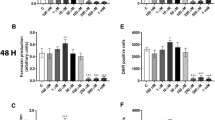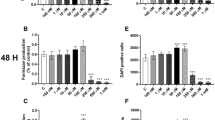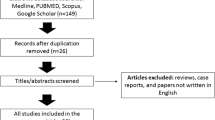Abstract
Perfluorooctane sulfonate (PFOS) (C8F17SO3) and perfluorooctanoic acid (PFOA) (C8HF15O2) are synthetic chemicals widely used in industrial applications for their hydrophobic and oleophobic properties. They are persistent, bioaccumulative, and toxic to mammalian species. Their widespread distribution on earth and contamination of human serum raised concerns about long-term side effects. They are suspected to be carcinogenic through a nongenotoxic mode of action, a mechanism supported by recent findings that PFOS induced cell transformation but no genotoxicity in Syrian hamster embryo (SHE) cells. In the present study, we evaluated carcinogenic potential of PFOA using the cell transformation assay on SHE cells. The chemical was applied alone or in combination with a nontransformant concentration of benzo[a]pyrene (BaP, 0.4 μM) in order to detect PFOA ability to act as tumor initiator or tumor promoter. The results showed that PFOA tested alone in the range 3.7 × 10−5 to 300 μM did not induce SHE cell transformation frequency in a 7-day treatment. On the other side, the combination BaP/PFOA induced cell transformation at all PFOA concentrations tested, which revealed synergistic effects. No genotoxicity of PFOA on SHE cells was detected using the comet assay after 5 and 24 h of exposure. No significant increase in DNA breakage was found in BaP-initiated cells exposed to PFOA in a 7-day treatment. The whole results showed that PFOA acts as a tumor promoter and a nongenotoxic carcinogen. Cell transformation in initiated cells was observed at concentrations equivalent to the ones found in human serum of nonoccupationally and occupationally exposed populations. An involvement of PFOA in increased incidence of cancer recorded in occupationally exposed population cannot be ruled out.






Similar content being viewed by others
References
Abdellatif AG, Préat V, Taper HS, Roberfroid M (1991) The modulation of rat liver carcinogenesis by perfluorooctanoic acid, a peroxisome proliferator. Toxicol Appl Pharmacol 111:530–537
Alexander BH, Olsen GW (2007) Bladder cancer in perfluorooctanesulphonyl fluoride manufacturing workers. AEP 17(6):471–478
Berenblum I (1941) The mechanism of carcinogenesis: a study of the significance of cocarcinogenic action and related phenomena. Cancer Res 1:807–814
Berwald Y, Sachs L (1963) In vitro cell transformation with chemical carcinogens. Nat 200:1182–1184
Berwald Y, Sachs L (1965) In vitro transformation of normal cells to tumor cells by carcinogenic hydrocarbons. J Natl Cancer Inst 35:641–661
Bessi H, Rast C, Rether B, Nguyen-Ba G, Vasseur (1995) Synergistic effects of chlordane and TPA in multistage morphological transformation of SHE cells. Carcinogenesis 16(2):237–244
Biegel LB, Hurtt ME, Frame SR, O’Connor JC, Cook JC (2001) Mechanisms of extrahepatic tumor induction by peroxisome proliferators in male CD rats. Toxicol Sci 60(1):44–55
Calafat AM, Needham LL, Kuklenyik Z, Reidy JA, Tully JS, Aguilar-Villalobos M, Naeher LP (2006) Perfluorinated chemicals in selected residents of the American continent. Chemosphere 63:490–496
Calafat AM, Wong LY, Kuklenyik Z, Reidy JA, Needham LL (2007) Polyfluoroalkyl chemicals in the U.S. population: data from the National Health and Nutrition Examination Survey (NHANES) 2003–2004 and comparisons with NHANES 1999–2000. Environ Health Perspect 115(11):1596–1602
Cheng X, Klaassen CD (2006) Regulation of mRNA expression of xenobiotic transporters by the pregnane-X receptor (PXR) in mouse liver, kidney, and intestine. Drug Metab Dispos 34:1863–1867
Cheng X, Klaassen CD (2008) Perfluorocarboxylic acids induce cytochrome P450 enzymes in mouse liver through activation of PPAR-α and CAR transcription factors. Toxicol Sci 106(1):29–36
Chouroulinkov I, Lasne C (1978) Two stage (initiation-promotion) carcinogenesis in vivo and in vitro. Bull Cancer 65:255–264
Clapham DE (1995) Calcium signaling. Cell 80:259–268
Collins AR (2009) Investigating oxidative DNA damage and its repair using the comet assay. Mutat Res 681(1):24–32
Collins AR., Dusinska M (2002) Oxidation of cellular DNA measured with the comet assay. In: Armstrong D (ed) Methods in molecular biology, vol 186, Oxidative Stress Biomarkers and Antioxidant Protocols Humana, Totowa, NJ, pp 147–159
Cruciani V, Rast C, Alexandre G, Nguyen-Ba G, Vasseur P (1999) Peroxisome proliferators-induced transformation of Syrian hamster embryo cells: influence of experimental procedures. Toxicol In Vitro 13(3):445–457
De Boeck M, Touil N, De Visscher G, Aka Vande P, Kirsch-Volders M (2000) Validation and implementation of an internal standard in Comet assay analysis. Mutat Res 469(2):181–197
Dhalluin S, Elias Z, Cruciani V, Bessi H, Poirot O, Rast C, Gate L, Pages N, Tapiero H, Vasseur P, Nguyen-Ba G (1998) Two-stage exposure of Syrian hamster embryo cells to environmental carcinogens: superinduction of ornithine decarboxylase correlates with increase of morphological transformation frequency. Int J Cancer 75:744–749
Elias Z, Poirot O, Pezerat H, Suquet H, Schneider O, Daniere MC, Terzetti F, Baruthio F, Fournier M, Cavelier C (1989) Cytotoxic and neoplastic transforming effects of industrial hexavalent chromium pigments in Syrian hamster embryo cells. Carcinogenesis 10:2043–2052
Eriksen KT, Raaschou-Nielsen O, Sørensen M, Roursgaard M, Loft S, Møller P (2010) Genotoxic potential of the perfluorinated chemicals PFOA, PFOS, PFBS, PFNA and PFHxA in human HepG2 cells. Mutat Res /Gen Toxicol Environ Mutagen 700(1–2):39–43
EU (2006) Directive 2006/122/ECOF of the European Parliament and of the Council of 12 December 2006. Official Journal of the European Union, L/372/32-34, 27.12.2006
Faust F, Kassie F, Knasmüller S, Boedecker RH, Mann M, Mersch-Sundermann V (2004) The use of the alkaline comet assay with lymphocytes in human biomonitoring studies. Mutat Res 566:209–229
Fernandez Freire P, Perez Martin JM, Herrero O, Peropadre A, de la Peña E, Hazen MJ (2008) In vitro assessment of the cytotoxic and mutagenic potential of perfluorooctanoic acid. Toxicol Vitr 22:1228–1233
Florentin A, Deblonde T, Diguio N, Hautemaniere A, Hartemann P (2011) Impacts of two perfluorinated compounds (PFOS and PFOA) on human hepatoma cells: cytotoxicity but no genotoxicity? Int J Hyg Environ Health 214:493–499
Fromme H, Midasch O, Tawardella D, Angerer J, Boehmer S, Libl B (2007) Occurrence of perfluorinated substances in an adult German population in South Bavaria. Int Arch Occup Environ Health 80:313–319
Fromme H, Tittlemier SA, Lkela WV, Wilhelm M, Twardellaa D (2009) Perfluorinated compounds—exposure assessment for the general population in western countries. Int J Hyg Environ Health 212:239–270
Giesy JP, Kannan K (2001) Global distribution of sulfonate de perfluorooctane in wildlife. Environ Sci Technol 35(7):1339–1342
Giesy JP, Kannan K (2002) Perfluorochemical surfactants in the environment. Environ Sci Technol 36(7):146A–152A
Gilliland FD, Mandel JS (1993) Mortality among employees of a perfluorooctamoic acid production plant. J Occup Med 35(9):950–954
Guerrero-Preston R, Goldman LR, Brebi-Mieville P, Ili-Gangas C, LeBron C, Hernández-Arroyo M, Witter FR, Apelberg BJ, Roystacher M, Jaffe A, Halden RU, Sidransky D (2010) Global DNA hypomethylation is associated with in utero exposure to cotinine and perfluorinated alkyl compounds. Epigenetics 5–6:539–546
Guruge KS, Yeung LWY, Yamanaka N, Miyazaki S, Lam PKS, Giesy JP, Jones PD, Yamashita N (2006) Gene expression profiles in rat liver treated with perfluorooctanoic acid (PFOA). Toxicol Sci 89(1):93–107
Hu X-Z, Hu D-C (2009) Effects of perfluorooctanoate and perfluorooctane sulfonate exposure on hepatoma Hep G2 cells. Arch Toxicol 83:851–861
Hu W, Jones PD, Celius T, Giesy JP (2005) Identification of genes responsive to PFOS using gene expression profiling. Environ Toxicol Pharmacol 19:57–70
Ikeda T, Aiba K, Fukuda K, Tanaka M (1985) The induction of peroxisome proliferation in rat liver by perfluorinated fatty acids, metabolically inert derivatives of fatty acids. J Biochem 98(2):475–482
Isfort RJ, Leboeuf RA (1996) Application of in vitro cell transformation assays to predict the carcinogenic potential of chemicals. Mutat Res 365:161–173
Jacquet N, Maire M-A, Landkocz Y, Vasseur P (2011) Carcinogenic potency of perfluorooctane sulfunate (PFOS) on Syrian hamster embryo (SHE) cells. Arch Toxicol 86(2):305–314. doi:10.1007/s00204-011-0752-8
Journal EFSA (2008) Opinion of the scientific panel on contaminants in the food chain on perfluorooctane sulfonate (PFOS), perfluorooctanoic acid (PFOA) and their salts. Eur Food Saf Authority J 653:1–131
Kannan K, Corsolini S, Falandysz J, Oehme G, Focardi S, Giesy JP (2002) Perfluorooctanesulfonate and related fluorinated hydrocarbons in marine mammals, fishes and birds from coasts of the Baltic and the Mediterranean seas. Environ Sci Technol 36(15):3210–3216
Kannan K, Corsolini S, Falandysz J, Fillman G, Kumar KS, Loganathan BG, Modh MA, Olivero J, Wouve NV, Yang JH, Aldous KM (2004) Perfluorooctane sulphonate and related fluorochemicals in human blood from several countries. Environ Sci Technol 38:4489–4495
Landkocz Y, Poupin P, Atienzar F, Vasseur P (2011) Transcriptomic effects of di-(2-ethylhexyl)-phthalate in Syrian hamster embryo cells: an important role of early cytoskeleton disturbances in carcinogenesis? BMC Genomics 12:524e
Lau C, Anitole K, Hodes C, Lai D, Pfahles-Hutchens A, Seed J (2007) Perfluoroalkyl acids: a review of monitoring and toxicological findings. Toxicol Sci 99(2):366–394
Liu X, Jin Y, Liu W, Wang F, Hao S (2011) Possible mechanism of perfluorooctane sulfonate and perfluorooctanoate on the release of calcium ion from calcium stores in primary cultures of rat hippocampal neurons. Toxicol In Vitro 25:1294–1301
Maire MA, Pant K, Phrakonkham P, Poth A, Schwind K-R, Rast C, Wilson Bruce S, Sly JE, Bohnenberger S, Kunkelmann T, Schulz M, Vasseur P (2012) Recommended protocol for the Syrian hamster embryo (SHE) cell transformation assay. Mutat Res/Gen Toxicol Environ Mutagen 744(1):76–81
Nilsson R, Beije B, Préat V, Erixon K, Ramel C (1991) On the mechanism of the hepatocarcinogenicity of peroxisome proliferators. Chem Biol Interact 78(2):235–250
OECD (2002). Hazard assessment of perfluorooctane sulfonate (PFOS) and its salts. ENV/JM/RD(2002)17/FINAL. Joint meeting of the chemicals committee and the working party on chemicals, pesticides, and biotechnology, Environment Directorate, Organisation for Economic Co-operation and Development (Paris). Available at URL http://www.oecd.org/dataoecd/23/18/2382880.pdf
OECD (2005). Results of survey on production and use of PFOS, PFAS and PFOA, related substances and products/mixtures containing these substances. ENV/JM/MONO(2005)1. Organisation for Economic Co-operation and Development, Paris. http://www.oecd.org/dataoecd/56/5/37863750.pdf
OECD (2007). Detailed review paper on cell transformation assays for detection of chemical carcinogens. ENV/JM/MONO18/2007-08-13. In: Series on testing and assessment, No 31. Organisation for Economic Co-operation and Development, Paris. http://www.oecd.org/dataoecd/56/5/37863750.pdf
Olsen GW, Church TR, Larson EB, Belle GV, Lundberg JK, Hansen KJ, Burris JJ, Mandel JH, Zobel LR (2004) Serum concentrations of perfluorooctanesulfonate and other fluorochemicals in an elderly population from Seattle, Washington. Chemosphere 54:1599–1611
Olsen GW, Burris JM, Ehresman DJ, Froehlich JW, Seacat AM, Butenhoff JL, Zobel LR (2007) Half-life of serum elimination of perfluorooctanesulfonate, perfluorohexanesulfonate, and perfluorooctanoate in retired fluorochemical production workers. Environ Health Perspect 115(9):1298–1305
Panaretakis T, Shabalina IG, Grandér D, Shoshan MC, DePierre JW (2001) Reactive oxygen species and mitochondria mediate the induction of apoptosis in human hepatoma hepg2 cells by the rodent peroxisome proliferator and hepatocarcinogen, perfluorooctanoic acid. Toxicol Appl Pharmacol 173:56–64
Pienta RJ, Poiley JA, Lebherz WB III (1977) Morphological transformation of early passage golden Syrian hamster embryo cells derived from cryopreserved primary cultures as a reliable in vitro bioassay for identifying diverse carcinogens. Int J Cancer 19:642–655
Pogribny IP, Tryndyak VP, Boureiko A, Melnyk S, Bagnyukova TV, Montgomery B, Rusyn I (2008) Mechanisms of peroxisome proliferator-induced DNA hypomethylation in rat liver. Mutat Res/Fund Mol Mech Mutagenesis 644(1–2):17–23
Rivedal E, Sanner T (1982) Promotional effect of different phorbol esters on morphological transformation of hamster embryo cells. Cancer Lett 17:1–8
Rosen MB, Thibodeaux JR, Wood CR, Zehr RD, Schmid JE, Lau C (2007) Gene expression profiling in the lung and liver of PFOA-exposed mouse fetuses. Toxicology 239:13–33
Rosen MB, Lau C, Corton JC (2009a) Does exposure to perfluoroalkyl acids present a risk to human health? Toxicol Sci 111(1):1–3
Rosen MB, Schmid JE, Das KP, Wood CR, Zehr RD, Lau C (2009b) gene expression profiling in the liver and lung of perfluorooctane sulfonate-exposed mouse fetuses: comparison to changes induced by exposure to perfluorooctanoic acid. Reprod Toxicol 27:278–288
Singh NP, McCoy MT, Tice RR, Schneider EL (1988) A simple technique for the quantitation of low levels of DNA damage in individual cells. Exp Cell Res 175:184–191
Takacs ML, Abbott BD (2007) Activation of mouse and human peroxisome proliferator-activated receptors (alpha, beta/delta, gamma) by perfluorooctanoic acid and perfluorooctane sulfonate. Toxicol Sci 95:108–117
Tarantini A, Maitre A, Lefebvre E, Marques M, Marie C, Ravanat JL, Douki T (2009) Relative contribution of DNA strand breaks and DNA adducts to the genotoxicity of benzo[a]pyrene as a pure compound and in complex mixtures. Mutat Res/Fund Mol Mech Mutagen 671(1–2):67–75
Tice RR, Agurell E, Anderson D, Burlinson B, Hartmann A, Kobayashi H, Miyamae Y, Rojas E, Ryu JC, Sasaki YF (2000) Single cell gel/comet assay: guidelines for in vitro and in vivo genetic toxicology testing. Environ Mol Mutagen 35:206–221
Tilton SC, Orner GA, Benninghoff AD, Carpenter HM, Hendricks JD, Pereira CB, Williams DE (2008) Genomic profiling reveals an alternate mechanism for hepatic tumor promotion by perfluorooctanoic acid in rainbow trout. Environ Health Perspect 116:1047–1055
Uhl M, Helma C, Knasmüller S (1999) Single-cell gel electrophoresis assays with human-derived hepatoma (Hep G2) cells Mutat Res/Gen Toxicol. Environ Mutagen 441(2):215–224
Vanden Heuvel JP, Thompson JT, Frame SR, Gillies PJ (2006) Differential activation of nuclear receptors by perfluorinated fatty acid analogs and natural fatty acids: a comparison of human, mouse, and rat peroxisome proliferator-activated receptor-α, -β, and -γ, liver X receptor-β, and retinoid X receptor-α. Toxicol Sci 92(2):476–489
Vanparys P, Corvi R, Aardema M, Gribaldo L, Hayashi M, Hoffmann S, Schechtman L (2010) ECVAM prevalidation of three cell transformation assays. ALTEX 27:267–270
Wolf CJ, Takacs ML, Schmid JE, Lau C, Abbott BD (2008) Activation of mouse and human peroxisome proliferator–activated receptor alpha by perfluoroalkyl acids of different functional groups and chain lengths. Toxicol Sci 106:162–171
Yamamoto Y, Rick MR, Flavell RA, Binfeng Lu B, Masahiko Negishi M (2010) Nuclear receptor CAR represses TNFα-induced cell death by interacting with the anti-apoptotic GADD45B. PLoS One 5(4):e10121
Yang Q, Ito S, Gonzalez FJ (2007) Hepatocyte-restricted constitutive activation of PPARα induces hepatoproliferation but not hepatocarcinogenesis. Carcinogenesis 28(6):1171–1177
Yao X, Zhong L (2005) Genotoxic risk and oxidative DNA damage in HepG2 cells exposed to perfluorooctanoic acid. Mutat Res 587:38–44
Acknowledgments
This study was granted by the Region Lorraine Ministry of Research within CPER Research Programme in France, and Fonds Européens de Développement Régional. The authors are grateful to Dr. Ennen-Simard and her colleagues from the Thionville Bel Air Hospital, Department of Oncology, Radiotherapy, and Curietherapy for the irradiation of SHE feeder cells.
Author information
Authors and Affiliations
Corresponding author
Additional information
Responsible editor: Philippe Garrigues
Rights and permissions
About this article
Cite this article
Jacquet, N., Maire, M.A., Rast, C. et al. Perfluorooctanoic acid (PFOA) acts as a tumor promoter on Syrian hamster embryo (SHE) cells. Environ Sci Pollut Res 19, 2537–2549 (2012). https://doi.org/10.1007/s11356-012-0968-z
Received:
Accepted:
Published:
Issue Date:
DOI: https://doi.org/10.1007/s11356-012-0968-z




